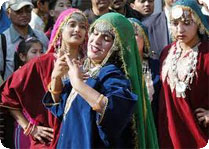
Jammu and Kashmir has few of the most captivating forms of performing arts in India that has captured the imaginations of one and all. These dances have become a non detachable part of this state's culture and are performed at almost all festivals and celebrations. There are special dances for almost all occasions like birth celebrations, wedding ceremonies, crop harvesting. Be it the dances of J&K or the music, they have this special aura about them that make you feel as a part of the performance even if you are just a spectator watching it in front of your eyes or sitting miles away enjoying it through media. There are many shows organized as well where you can witness the mesmerizing art forms apart from watching them in festive celebrations. This makes Jammu and Kashmir a hot favorite destination among tourists.
Ruf Dance:This is one of the most famous dance forms that is practiced in J&K. The dance has been a part of Kashmiri life from ancient times. In the capital city, it is pronounced as 'Row' but in villages, it is pronounced as 'Ruf'. This dance is performed as a welcoming dance for the spring season. You will see most number of performances during the prelude of spring season. The dance is clearly inspired by bee and it is the lovemaking of the bee that is portrayed in the dance. In the dance, two or four groups are formed consisting of 2 to 3 charming women. They stand facing each other and hold the hand of the adjacent partner. The women together sway their feet forward and then to back. The song that is sung during the performance is in the form of question and answer form where one group questionand the other respond to it in a rhythmic way.
Bachha Nagma Dance:Bachha Nagma, also known as 'Bachha gyavaun' means 'adolescent melodious voice. The dance is quite famous among people here and is an important cultural event during marriage ceremonies or any cultural celebrations. The dance is performed only by boys or by men dressed as boys. The attire of the dancers has a resemblance with the dress that is worn by Kathak dancers. The dance group has six to seven members consisting of one lead singer. Generally, the dancers themselves are the singers and since most of them are boys, the songs are quite soft sounding and create a soothing environment.
Dandaras Dance:Performed mostly during the time of Lori festival, this is a highly professional dance that asks for high levels of skills and practice. A model of peacock that is made of bamboos and colored paper is carried by every group and every member has a stick in his hand. During the dance, the performers hit the stick in the hand of other person in different postures that is not as simple as it looks. The dance is really very energetic and one must surely witness it when he is in Jammu and Kashmir.
Ladishah:Ladishah is tremendously famous and holds an important position in Kashmiri music tradition. Ladishah is a sarcastical form of singing. The songs are sung resonating the present social and political conditions and are utterly humorous. The singers move from village to village performing generally during the harvesting period. The songs are composed on the spot on issues relating to that village, be it cultural, social or political. The songs reflect the truth and that sometimes makes the song a bit hard to digest, but they are totally entertaining.
Music adds to the attraction of the Kashmir valley for the tourists. The history and tradition of music and dance in Kashmir valley goes back to thousands years back. Given below are some main forms of the traditional music of Kashmir, along with some Kashmiri folk songs:
Chakri:Once performed with the help of only Garaha, Sarangi and Rabab, Chakri has included harmonium also in its presentation. It is one of the most popular forms of the traditional music of Kashmir.
Sufiana Music:Sofians musiqui (Sufi Music) owes its introduction in Kashmir to Iran. Introduced in the 15th century in the Kashmir valley, Sufiana music continues to enthrall its audience till date. With the passage of time, a number of Indian ragas were added to this music form. This classical music form of Kashmir makes the use of Santoor, Sitar, Kashmiri Saz, Wasool or Tabla.
Hafiz Nagma:A part of the classical Sufiana Music, Hafiz Nagma makes use of Santoor-a hundred stringed instrument played with sticks. In Hafiz Nagma, there is a female dancer, accompanied by a number of males with instruments. The dancer, known as Hafiza, moves her feet to the musical notes.
Song of Habba Khatoon:Habba Khatoon was a princess of Kashmir. This song reflects her feelings at the time when she was separated from the Yousuf King.
Surma:Surma is a song in Dogri that reflects the agony of a newly married girl whose husband is away in the Army.